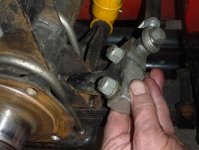Offline
Just noticed my panhard rod mount at the axle has broken the welds and is non-functional.
In normal (non-race) driving, does the panhard rod provide any benefit? I know what it's supposed to do, just not sure I noticed any difference with it broken.
This is a Cape International "uprated bar" with a Heim joint at the axle end. This may have caused the break, as the stock setup has rubber bushes at both ends.
In normal (non-race) driving, does the panhard rod provide any benefit? I know what it's supposed to do, just not sure I noticed any difference with it broken.
This is a Cape International "uprated bar" with a Heim joint at the axle end. This may have caused the break, as the stock setup has rubber bushes at both ends.

 Hi Guest!
Hi Guest!

 smilie in place of the real @
smilie in place of the real @
 Pretty Please - add it to our Events forum(s) and add to the calendar! >>
Pretty Please - add it to our Events forum(s) and add to the calendar! >> 


